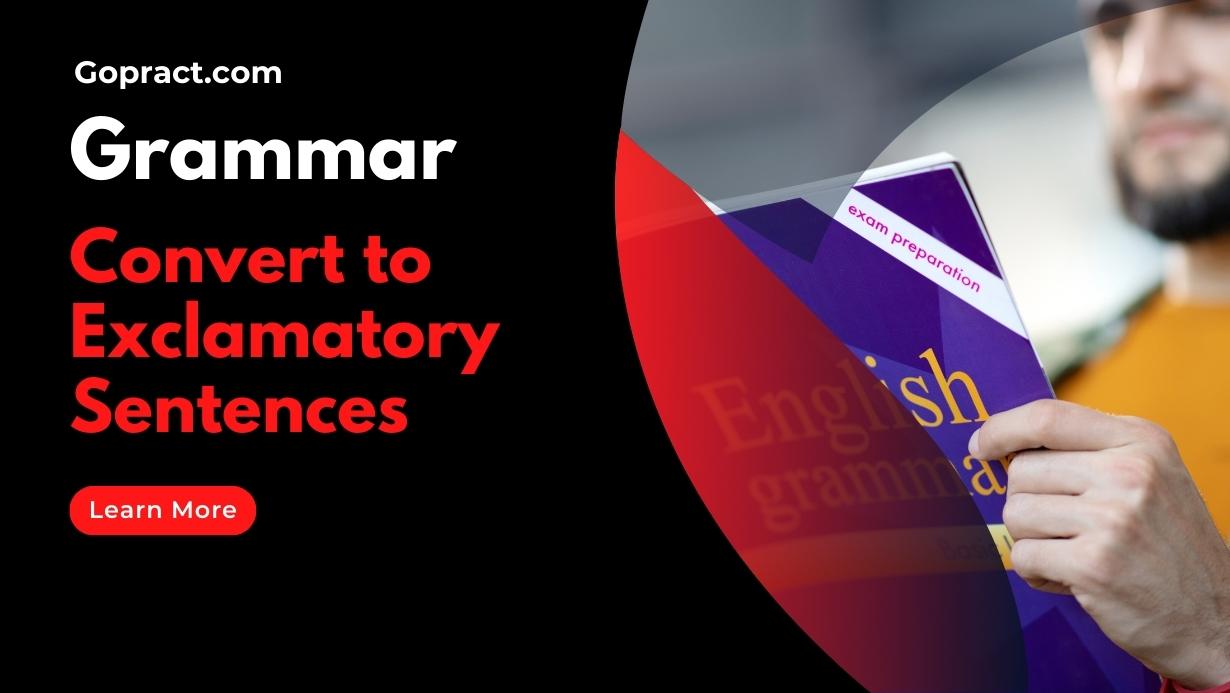- Home
- All Blogs
-
Types of exclamatory sentences and how to convert into exclamatory sentence?
Types of exclamatory sentences and how to convert into exclamatory sentence?
Published On:
1/30/2024
Author:
Admin
Using different sentence types is crucial for creating well-rounded and impactful communication, allowing writers to express themselves with clarity, engage their audience effectively, and adapt their style to suit the purpose and context of their writing.
Let's delve into a crucial subject – the Exclamatory Sentence. This topic holds significant importance, particularly as it is a recurring theme in English language papers for SSC and HSC examinations. Furthermore, it stands out as a vital area in competitive, screening, and recruitment exams. These exams often feature questions related to sentence formation and conversion from assertive to exclamatory, and vice versa. Notable examinations where such inquiries are posed include MH LLBCET, AILET, RRB Exams, IBPS Exams, Recruitment Exams, Placement Papers in IT industry and more.

An exclamatory sentence is a type of sentence that conveys strong emotion, surprise, excitement, or a sense of urgency. Exclamatory sentences are characterized by their punctuation, typically ending with an exclamation mark (!). These sentences are used to express heightened emotions, enthusiasm, or a strong reaction to a situation. Exclamatory sentences often stand out for their expressive and dramatic tone, and they are commonly used in both spoken and written communication to emphasize a point or evoke a specific emotional response from the reader or listener.
Exclamatory sentences are marked by the exclamation mark, an expressive tone, specific word order, and the inclusion of interjections or exclamatory words. These characteristics collectively contribute to the unique and impactful nature of exclamatory sentences.
Some Examples of Exclamatory Sentences are as follows:
- What a beautiful sunset!
- I can't believe we won!
- How amazing the performance was!
- Oh no, I forgot my keys!
- Bravo! That was an outstanding achievement.
As evident from the examples above, the exclamation mark (!) is the prevailing punctuation mark used in exclamatory sentences. Positioned at the sentence's conclusion, it signifies intense emotion, excitement, surprise, or urgency. Acting as a visual cue, it indicates the exclamatory nature of the statement.
Assertive sentences are converted to exclamatory ones to serves various purposes, including expressing emotion, adding emphasis, creating a dynamic tone, and engaging the reader. The decision to convert depends on the desired emotional impact and the communicative goals in a given context.
Classification of Exclamatory sentences
Exclamatory sentences can be classified into different types based on their specific purposes or the emotions they convey. Here are some common types of exclamatory sentences:
1. Expressive Exclamations : These sentences convey strong emotions, such as excitement, joy, surprise, or enthusiasm. They often include exclamatory words or interjections to emphasize the emotional tone.
Example: What a stunning view!
2. Exclamatory Statements : These sentences make exclamatory remarks or observations without necessarily expressing strong emotions. They may convey admiration, appreciation, or acknowledgment.
Example: That is an incredible achievement!
3. Exclamatory Commands : These sentences express commands or requests with a sense of urgency or emphasis, often using the imperative mood.
Example: Stop right there!
4. Exclamatory WishesThese sentences express desires, hopes, or wishes with a heightened emotional tone.
Example: I wish you a fantastic birthday!
5. Exclamatory Greetings : These sentences are used to express enthusiastic greetings or salutations.
Example: Hello, everyone!
6. Exclamatory Responses : These sentences serve as responses to surprising or unexpected situations, expressing the speaker's immediate reaction.
Example: Oh my goodness!
7. Exclamatory Interjections : These sentences consist mainly of interjections or exclamatory words expressing a sudden burst of emotion.
Example: Wow! That was amazing!
8. Exclamatory Calls for Attention These sentences are used to grab the listener's or reader's attention, often by expressing a sense of urgency or importance.
Example: Look at this!
9. Exclamatory demonstratives : These sentences use demonstrative pronouns to express a strong reaction to a specific object or situation.
Example: This is incredible!
10. Exclamatory Declarations : These sentences make bold declarations with a strong emotional emphasis.
Example: I am so proud of you!
Subjects (Free Online Tests)
Your Comment:
(2) Comments:
|
SANKET SOMESHWAR JADHAV |
Commented On: 20-Feb-2024 |
|
SANKET SOMESHWAR JADHAV |
Commented On: 20-Feb-2024 |
Your Daily Dose of GK (05 Jan 2026)
Stay updated with today’s most important current affairs and trending topics (05 Jan 2026).
Watch our daily informative video designed specially for competitive exam preparation and boost your General Knowledge, awareness, and exam confidence—every single day.